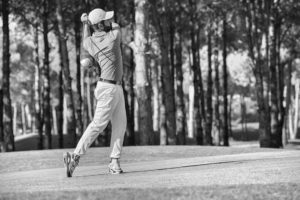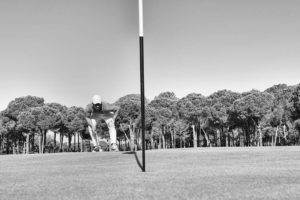Approximately 10 percent of the population is left-handed. In a world dominated by right-handed people, being left-handed, using left handed golf drivers can have a lot of downsides.

In sports, however, southpaws get the spotlight.
Unfortunately, some games that require the use of equipment can become quite troublesome for left-handed players because almost all manufacturers make equipment catered to righties.
Golf, in particular, is one of those sports with limited equipment for lefties. Don’t give up just yet on this sport if you’re left-handed.
There are a lot of ways to improve your game using the right tools and methods! This article, in particular, will delve into left handed golf drivers, and how to maximize its use in every game.
Left-handed player’s guide to golf
Golf can be as simple as using a club to sink a golf ball into its respective hole! For lefties, however, it can be somewhat of a challenge. Among golfers, only 5 to 7 percent are left-handed.
Thus, the majority of the teaching materials in golf are in the perspective of righties; and golf instructors mostly teach the right-handed way of playing.
Which, in turn, makes people think that this is solely the correct method of playing.
Since drivers are typically used at the start of a game to strike the golf ball off the tee, you need to sharpen your skills with it using your dominant hand.
Assuming that you already know the basics to golf, here are some helpful tips for left-handed golf drivers that can make you enjoy and succeed in this sport:
Purchase the right equipment
Custom-made golf clubs for left-handed players are challenging to acquire and are priced higher.
Techniques can be learned and mastered, but specific golfing equipment manufactured explicitly for lefties is really just hard to get a hold of.
Although it is not easy to acquire, left-handed golf clubs will make it easier for you to perfect your swing.
If you really want to improve your game, you should consider ordering custom-made clubs that fit well with your physical stats and playing strategy.
It is important to note that only 25 percent of all golf clubs come with a left-handed option for buyers. Some stores offer specific clubs, like left-handed golf drivers and putters.
However, if you are on a budget, second-hand equipment for lefties can be bought from legitimate sellers online or in specialty stores.
Think and play like a leftie
To properly play golf, left-handed players should try to avoid playing like a rightie.
Some people find it hard to readjust the direction of their swing because they are naturally oriented to the left side, yet they still adhere to the right-handed way of playing golf.
Practice swinging your golf club in the way that is most comfortable and natural to you.
It is also necessary for you to learn the proper grip to avoid a slice (a dramatic curve in the golf ball’s flight). Always use your dominant hand to provide steadiness in your grasp.
Practice slow motion golf swing driver
It is quite difficult for drivers to hit with accuracy, even for righties. In order to improve performance, using left handed golf drivers is a must.
Some popular left handed golf drivers are the:
- TaylorMade M4 Driver
- Callaway Big Bertha Fusion Driver
- Titleist 917D2 Driver
Moreover, focusing on accuracy rather than distance is vital. With this, you should keep your swing slow.
Swinging too fast can result in a hook that causes your ball to curve from left-to-right in flight.
It is highly advisable to perfect these swings in the practice range so that you can focus more on your precision in a controlled environment.
Doing slow motion golf swing driver practices can help improve accuracy, so make sure to let your driver do most of the work for you at its own moderate pace.
Learn the basics of left-handed golf drivers
Aside from using a left-handed golf driver and practicing slow motion golf swing driver, it is also necessary to learn more about factors such as tee height, golf ball position, player posture, and movement.
Before you practice how to address a golf ball with a driver, You should learn the following basic knowledge:
-
Tee Height and Golf Ball Position
Begin by using a sizable tee (over two inches) and setting your tee ball high. Place the golf ball closer to your right leg, which should be about two lengths nearer to the front of your right foot.
-
Player Posture
You should stand in an optimal position with your right shoulder facing the target and your right foot being even with your shoulder blade.
-
Movement
Fully rotating your body and hips as you hit the ball can help you achieve successful shots since this movement dramatically improves the power of your swing.
The rotation should be led by your right hip, followed by your arms and hands. Your dominant hand, and subsequently, your dominant side, should give enough power to your driver when hitting the ball.
In this case, the right-hand leads the swing, and the left-hand finishes. End your swing by landing on the balls of your feet.
You should always practice this to prevent landing on your heels, which would consequently lessen the power of your swing.
Try these useful tricks
Prevent your shots from going bad by practicing these tried-and-tested methods that would teach you how to address a golf ball with a driver and how to fade a driver in golf:
How to address a golf ball with a driver
- To address a golf ball with a driver effectively, you should first remember to relax your body. Becoming too tense can affect your grip, posture, movement, thereby affecting your overall swing.
- Maintain a reasonable distance from the ball. Standing too far or too near can affect your swing. The distance between you and the golf ball is determined by the length and angle of your club.
- Take note of the size of your driver club head. The clubface should squarely hit the target, so don’t change the loft, or the angle, of your club.
- Make yourself familiar with your swinging circle so you can place the ball within this area. This ensures that you strike the ball directly with the middle of your clubface.
- You can take control of the direction of the ball by getting yourself into golf posture:
- Feet aligned with your shoulders
- Slight bending of the knees
- Straight back tilted forward from the hip
- Arms straight, reaching forward
- Weight balanced and body stilled, yet relaxed
- Once you have established the correct position for the tee, the ball, the club, and your body, get ready to swing. Try not to turn the club with too much power to prevent your shots from becoming a slice or a hook.
How to fade a driver in golf
- Your body’s initial alignment with the ball should be open. This kind of stance will allow you to hit and direct the trajectory of the golf ball accurately.
- Position the ball forward and point your clubface towards the target. This helps you control the angle of the club and ensure that the club strikes the ball.
- In a wide stance, practice your swings with your feet moving into an out-to-in path.
Know what to avoid
One of the many things that can go wrong with your golf swing is when you top the golf ball with your driver.
Topped shots happen when your club only makes contact with the top half of the ball, leading to a weaker strike. Golf balls travel lower and typically end up in the ground faster than that of actual solid hits with a driver.
If topped shots keep happening in your games, you should learn how to stop topping the golf ball with driver!
Seasoned experts always get asked how to cure topping golf ball with driver, so we did the research for you!
To avoid topping the golf ball with the driver, there are three key areas that you need to evaluate:
- the ball
- your stance
- your swing
If you frequently find yourself topping the golf ball with your driver, you can adjust either one of these factors.
To help you envision this key tip in an actual game, you can view this video that would teach you the process of how to stop topping the golf ball with driver.
While you learn how to cure topping golf ball with driver.
Keep in mind that you still have to continually evaluate your performance using different positions to find the one comfortable for you and suitable for the course you are in.
For a clear visual on the proper set-up and stance to prevent topped shots, you can watch this video.
In Conclusion
Left-handed golf drivers can come across as a difficult thing to master.
The driver is arguably the golf club with the most striking power.
Use this to your advantage by learning how to address a golf ball, cure a topped shot, and fade a driver.
More Information
Last Updated on December 4, 2023 by Paul Roger Steinberg





